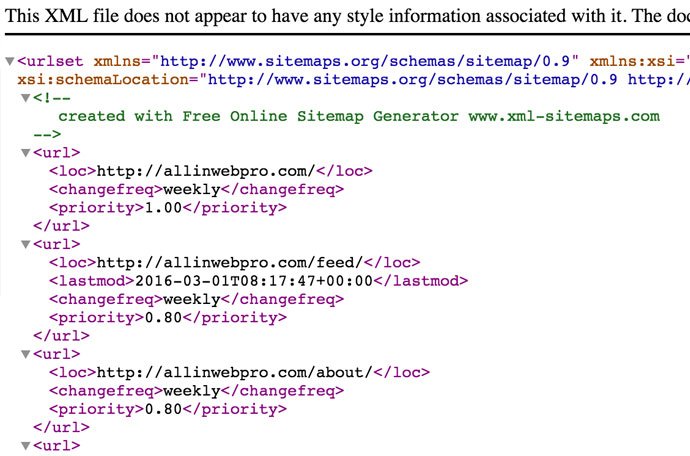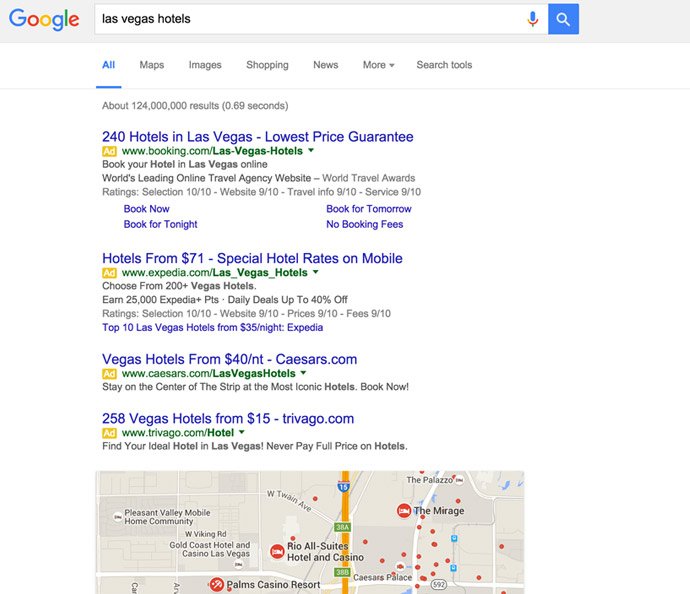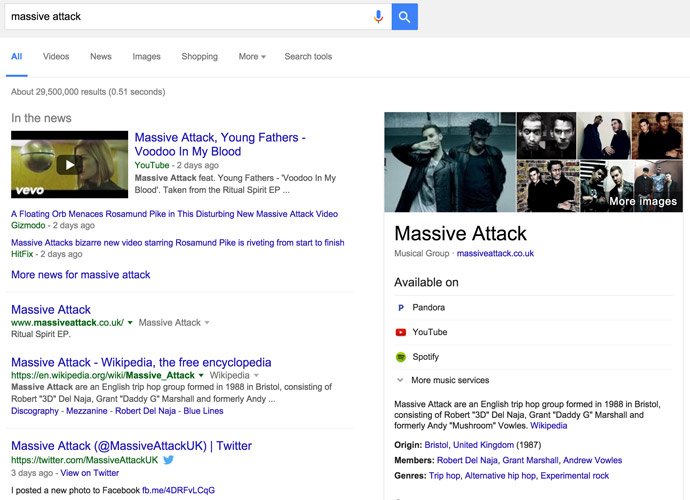Search Engine Rankings
How to Update your Sitemap.xml file for Google and Bing
Your Sitemap.xml file might not be up to date
Recently I've become inspired to create a multitude of new pages and blog posts for our All in Web Pro website to add a wealth of new content to our site to bring helpful information to our clients and site visitors, as well as to boost our ranking in Google searches. This week after publishing several new blog posts in a row I wanted to double check our sitemap.xml file to make sure Google & Bing had the most up to date list of all of our old and new webpages.
We'd been using a WordPress plugin called "Google XML Sitemaps" which had worked for us in the past and is designed to automatically update the sitemap.xml file anytime a page or post is created or updated on your WordPress website. This is important because you want all of your new webpages to be announced to search engines as soon as they're live on your website. And although search engines automatically rescan your website to look for new content and pages, submitting it to them directly can speed up the process and help those pages get indexed and seen by search engine users faster.
So after checking our sitemap.xml file that the Google XML Sitemaps plugin was generating, I noticed the blog posts I'd submitted a week earlier weren't appearing. I'm going to update our WordPress core and activate the plugin to see if it will start working again. But in the meantime I needed a way to update our sitemap quickly and manually to make sure it's appearing correctly with all of our links. Which is where the following short tutorial on how to update your sitemap.xml file begins.
What is a sitemap.xml file?
A sitemap.xml file that sits on your website's hosting server which tells search engines all of the pages on your website that exist, what priority you rank the pages in, when they were last updated, and how frequently you update them. This information helps Google & Bing know how often to rescan your website's pages for updates and which pages on your site are more important to show in search results. It's also a good way to announce the creation of new pages on your site to Google & Bing. The file is written in XML, which is similar but different from HTML, another type of "Markup Language, which is what the "ML" are abbreviations for. So it's important that your XML file is created correctly with no errors in the XML format.
Why is my sitemap.xml file so important?
If you want to have the best chance of showing up on the first page of a Google or Bing search when your potential customers or audience are doing relevant searches you need Google and Bing to know all of the pages on your website, which ones are the most important ones you want appearing, and also to include your most recently created content. If your sitemap is not up to date it will tell search engines that maybe your website isn't being updated and therefore might not have the most relevant and current information on it. Many other factors are taken into consideration, but when you know sitemaps have an impact on your search rankings and are an important part of SEO, why not be safe and make sure it's correct?!
5 Steps to Updating your sitemap.xml file
Here's a quick list of steps you can take to manually update your sitemap.xml file. Once finished you'll know it's live by simply go to your website homepage and add '/sitemap.xml' after '.com' or '.net'. (e.g. www.domain.com/sitemap.xml)
1. Generate your XML Sitemap file
There are several websites you can visit to generate a sitemap file for your website. I did a Google search for "sitemap generator" and found XML-Sitemap.com which worked well. Just enter your website URL and download the free files generated. The file we need is sitemap.xml.

2. Upload your sitemap.xml file to your website's root server
To get your sitemap.xml file onto your website's hosting server you'll need one of the following 2 things. A) The login & password to the hosting control panel for your website so you can utilize a file manager tool that your web hosts provides to upload the sitemap.xml file to your website's root (/) folder. B) You can download a free FTP (file transfer protocol) program to your computer, such as FileZilla, which will enable you to upload files directly to your website's hosting server. You'll still need to have an FTP user account created on your hosting account, which will have a username & password along with a hostname. For hostname you can usually just type your website domain name (e.g. allinwebpro.com), otherwise you can use the IP address of the web host server where your website's files are located, which your hosting company provides you.
3. Make sure sitemap.xml is in your server's root folder
The sitemap.xml file should be uploaded to the root folder of your website. This is usually the folder labeled '/', and is also usually the same folder where you'll find usually also see the 'index.php' and '.htaccess' files.

4. Verify your sitemap.xml file is live
Now go to your website and add the '/sitemap.xml' suffix to your website's domain name, like this: 'www.mydomain.com/sitemap.xml'. If the page you see looks something like this then it worked!
5. Submit your new sitemap to Google & Bing
Both Google and Bing have an advanced Webmaster Tools service where you can create an account and manage all of the different websites that you administrate. You'll need to verify that you control your website by following their verification instructions, which usually involves adding a snippet of code to the header or footer of your homepage. Once verified you can navigate to the 'sitemap' area of Webmaster Tools to submit or resubmit your sitemap.xml file. Both search engines have advanced tutorials and help information to help you complete this task, and both provide advanced reporting tools to let you know more about your website including any broken links, or how many pages are currently indexed vs what was submitted.
Other Options
Although this method works, it is a little time consuming and it would be much easier to simply upload a plugin to your WordPress dashboard that would automatically update your sitemap.xml file anytime changes were made to your site. I'm going to do some plugin tests and see if any are reliable and will update this blog post accordingly. But it's helpful to know how to manually create your own sitemap.xml file in the event that plugins become buggy or aren't picking up all of the links to your site, especially if you start using a subdomain which may be tricky for some automated plugins to read.
What Sitemap Tools Do You Use?
Please comment below if you found this sitemap.xml guide helpful, or if you have other websites, plugins, or tools that worked well for you.
About All in Web Pro
All in Web Pro is a Las Vegas Web & Graphic Design company that has been helping small and medium sized businesses unlock the power of the internet to accelerate their brands since 2010. If need help with your website or have want to know how to get more value out of your website, call our team today! 702-331-0650
Google Web Design Update: Removes Right Sidebar Ads
Without publishing an announcement Google has removed right sidebar ads from desktop browser search pages, now showing up to 4 paid ads at the top of searches before organic search results and up to 3 at the bottom of SERPs (search engine results pages). I'd like to think Google's update was inspired by the latest web design trends of 2016 which are shifting towards minimalism, simplicity, fewer simultaneous choices, and other feng-shui-like principles.
The change will significantly affect click-through rates and likely cost per click paid by advertisers for existing Google Adwords campaigns, especially for high traffic commercial keywords. The SEM Post reports that Adwords staff have confirmed that this change will be worldwide and permanent.

Previously high traffic searches would have 3 text ads at the top which will now change to 4 for highly commercial searches. The term 'commercial searches' will likely be any searches that yield high advertising revenue such as high CPC (Cost Per Click) and high volume search results with commercial intent.
Mobile search browsers won't see any changes for the time being and still display 3 text ads at the top of the page with up to 3 ads at the bottom of each search results page.
Google has been making lots of subtle changes to their search results page for a long time now, often performing many different experiments simultaneously across millions of users to optimize the experience of users based on changes in behavior patterns.
The removal of right sidebar ads, which are often ignored by savvy Google searchers, may be part of a longer-term strategy of Google attempting to make the right sidebar more useful and eventually more profitable through other forms of enhanced and more trustworthy content delivery. So just when you were about to sit back and enjoy the new whitespace of Google's new search page web design, you may need to start getting used seeing new more useful content there.
Examples of these shifts can be seen when searching for popular music groups which produce a wikipedia type fact chart where the right sidebar ads used to be. The change may also be partly associated with revenue models Google has calculated related to trends in revenue from ads in the sidebar compared to ads placed above organic content.
Either way, I'd like to say a big AMEN to whoever at Google had the smart idea to remove a little more clutter from our lives. They've done a great job of keeping their homepage clutter-free for so many year. Perhaps Google is now making this change in response to new trends in web design that are moving websites towards more simple, light-weight, and less cluttered designs for people searching for valuable information online.
How to Measure and Monitor your SEO for FREE
8 tips on how to keep track of your SEO for FREE
You can offer the best services or goods in your marketplace, but if those who are searching for what you sell find your competitor online instead of you, you will likely not earn their business. The research shows most consumers first look online when they are interested in making a purchase. The statistics are clear; over 80% of consumers will do their own search online well before they pull out their wallet to spend their money.
In order to know where you stand in regards to your competitors, it’s crucial you measure your SEO (search engine optimization) to establish your position, and to monitor it on an on-going basis. If you have the budget, SEO is one of the most dominant factors in your online marketing campaign and allocating the funds to have it professionally managed, will be some of the most valuable money you spend towards driving traffic to your site and bringing potential clients directly in touch with your brand. However, if you are not yet in a position to afford expert assistance with your SEO marketing, all is not lost. With some time and effort, you can use the following free tools to identify your ranking and monitor your position. For 6 free techniques you can put into practice today to power your SEO upwards, you can read our article 6 Simple SEO Habits to Increase Website Rankings & Traffic.
1. Google Analytics
You can sign up in minutes to begin taking advantage of this powerful, free tool. Google Analytics offers daily traffic statistics which you can sort and organize: per keywords, per visitor, per location, per referring website, per search engine, and by any time scale. Packed with useful features, it is a must have for anyone interested in measuring and tracking their website traffic and SEO progress.
2. Google Adwords' Keyword Tool
This powerful and free online resource allows you to see the number of searches that Google receives nationally, and internationally, for any specific keyword phrases. We recommend checking off the box that says "Exact" searches, not broad or matching, for the most accurate and relevant statistics. What this means to you is that now you can confidently know which keywords your target audience is searching for the most when they're looking for brands or businesses like yours online. We use this to help decide which keywords would be most profitable to target in our SEO campaigns for ourselves and our clients.
3. Understand the Power of Search Results Ranking.
On any Google search page in organic results: #1 gets 33% of clicks, #2 gets 22%, #3 gets 11%, #4 gets 7%, on down until #10 gets 1-3% share of link traffic. This shows how skewed the numbers are toward the top of the first page of Google. Because traffic is so heavily funneled to the first few listings, its easy to see how companies can become forgotten when they are not actively managing their SEO and staying on top of their ability to be found. Keep in mind that these numbers vary widely based on the industry you're in and how likely it is that people searching will be satisfied with the first search results versus continuing down the search results page looking for something the other results aren't providing.
4. MicroSiteMasters.com
This extremely valuable service provides Search Engine Results Page (SERP) rank reporting and tracking keywords in Google, Bing, and Yahoo, and their service is free for first 10 keywords. 10 keywords are more than sufficient to get started measuring the progress of your SEO efforts, and if you're not using a tool like this, you need to start now so you can begin understanding where you rank and how your rank changes over time.
5. HubSpot's Website Grader
In less than 30 seconds, HubSpot issues a report that analyzes all of your online marketing efforts, not just on your website, and gives you a Marketing Grade on a 1-100 scale. It doesn’t stop there; it recommends the next steps, in order of priority that you should take to improve your strategy. By assessing over 30 factors, HubSpot offers a comprehensive assessment and then provides a plan of action, complete with online resources to help put their recommendations into practice.
6. MajesticSEO.com
This website offers a free tool to track and analyze off-site backlink health of any website online, by total history or by recent growth. Use the power of MajesticSEO’s enormous link intelligence database to compare your backlink power to that of your competitors.
7. Google's "Site:" search
I use this tool everyday, even when just browsing because it's so powerful. Just try typing “site:examplesite.com" into the Google search bar, adding in a website use regularly, and then look at total search results for the number of pages indexed by Google. This normally tells you, with a fair amount of accuracy the total number of pages on any website, which can be used as a rough indicator of their on-site SEO credibility in Google. The total number of pages a website has can also roughly approximate how well established and trusted your website is according to Google search engine’s algorithm, this is because the longer a website has existed and the more valuable content they have online, the more it lends to the idea that they know what they're talking about, assuming that the content is relevant, unique, and that there's a decent amount of it on every page.
For even more fun, try adding search terms with a space just before where the "site:" appears, and you'll be amazed at how useful it is to be doing a Google search of pages ONLY on the website listed in the example. ("site:example.com")
8. Use "Page Source" / "View Source"
This is a simple, fast way to determine which keywords your webpages, and your competitors' webpages, are targeting. This is the basic information you need to assess where your current SEO is focused and vital to your understanding of what type of traffic you are attracting—or failing to attract. "Page Source" or "View Source" is a browser tool option which you can access in most browsers by doing right-click on the webpage on PCs or Option-click on Macs; it also appears in the browser's menu. Select this option and you will see the HTML code for the page. In the code, near the top of most webpages you should be able to see or find using CTRL+F the following text meta tags; look for <title>, <meta description >, <meta keywords > tags.
Pay attention to the first words that appear in these meta tags. These keywords can be used to analyze your competition and see what keywords they are telling Google to target for each of their webpages. The most important is the title tag, but the description tag is also very important to Google, because this is the text that appears in Google search results. Conversely, be sure your meta tags are telling search engines the right story about who you are and what content or keywords each webpage is primarily relevant to.
Based in Nevada, our Las Vegas web design team would be happy to answer any questions you may have about SEO. For more resources and helpful tips sign up for our newsletter or send us a message telling us what topics you'd like to see covered here. For now, don’t hesitate to get started with these useful resources that you can access free of charge anytime. We recommend always getting professional feedback and direction at the start of any SEO campaign, no matter how small, to ensure that you're not making any mistakes that could be costing you valuable traffic. We offer free consultations and are happy to educate our customers on the value of a well designed SEO campaign.
8 SEO Blogging Tips for Better Search Engine Rankings
Blog with Purpose for Success You Can Measure!
Blogging is something that's easy for anyone to do, if writing comes easy for you it can be as easy as typing an email message and clicking "Post"! But unless you're blogging with with a specific SEO related purpose or goal in mind and using easy to remember SEO (Search Engine Optimization) techniques in your blog posts, you might just be completely missing several huge opportunities to rank your website high in search engines for the popular search terms your audience is using and thus losing valuable traffic and business.
As a Las Vegas SEO company we've talked to many large and small companies about how to add value to their websites to improve rankings, and you'd be surprised at how little the vast majority of brands know about optimizing their blogs and content to rank high in search.
Here are 8 easy to remember SEO tips and blogging strategies that will be guaranteed to improve your website's traffic and rankings in the searches your customers are performing every day.
1. Know your top 10 keywords.
 Make sure you know what your top 10 keyword phrases are and know where you rank for them. Don’t forget that including a city name, using a different word order, or adding an “s” or “ing” after a word makes it a completely new keyword in Google’s eyes. To Google, “Las Vegas SEO”, “Vegas SEO”, and “LV SEO” are three completely different keywords. If you have no idea what interested users type into search engines when looking for information on companies in your industry, then you’re unable to target these keywords and make sure you show up when they are searching for you. For example, if you are a plumber and you are coming up when people search “clogged pipes”, but only 10% of users use that search, then well over half of your potential leads are finding your competitor, instead of you.
Make sure you know what your top 10 keyword phrases are and know where you rank for them. Don’t forget that including a city name, using a different word order, or adding an “s” or “ing” after a word makes it a completely new keyword in Google’s eyes. To Google, “Las Vegas SEO”, “Vegas SEO”, and “LV SEO” are three completely different keywords. If you have no idea what interested users type into search engines when looking for information on companies in your industry, then you’re unable to target these keywords and make sure you show up when they are searching for you. For example, if you are a plumber and you are coming up when people search “clogged pipes”, but only 10% of users use that search, then well over half of your potential leads are finding your competitor, instead of you.
2. Target 1-2 keywords per post.
When Google is deciding what webpage to show for a given search term, it usually won’t focus on webpages that cover a broad range of topics. Google is trying to give visitors the most relevant and focused content that relates to the keyword phrase that was searched. Keep the majority of your pages and blog posts focused on just 1 or 2 keywords at most when developing your content. Feel free to mention relevant topics but keep your message and content focused, visitors and search engines will thank and reward you for it.
3. Match content to keywords.
When it comes to looking credible, there’s nothing better than saying you’re going to do something and then following through and doing just that. Google will use the same logic when analyzing your use of keywords in your headers and meta tags in comparison your actual text content. If your page title says “Las Vegas Web Design” but the text content on the page never uses that keyword phrase, it will seem like something is not in alignment and all of your other SEO efforts will not be as effective.
4. Use 400+ words per page.
The length of a post is one of the factors search engines use in determining how valuable your content is and how high to rank it. There are several reasons why this will help make your blog post more legitimate and credible in the eyes of search engines, but all you need to understand to be able to use it to your advantage is that writing between at least 400 and 600 words will give your post a significant boost.
5. Blog weekly.
If your website does not currently have a blog, you are missing out on a principal opportunity to boost your SEO and establish yourself as a trusted authority in your industry. Blogging has many positive impacts on the usefulness of your website, but it also is great for your SEO. It adds fresh new content to your website, gives you the opportunity to target many new keywords, and also adds to the overall volume of relevant and high value content on your site. The more you blog the better, but setting a once a week goal is an easier habit to set and stick with than over doing it and getting discouraged and not doing anything. Set a realistic goal for creating content on a regular basis and you'll see your rankings climb.
6. Only use unique text content.
Text content is the life blood of SEO, and you will need a lot of it if you’re going to rank well in Google. However, you must never copy content from other websites to fill in the content areas of your site. Doing so will mark you as a copy-cat in Google’s eyes and the text will retain no value. Google rewards websites that present new valuable information to visitors. If you must use quotes or excerpts from other website, do so very sparingly and understand that it adds nothing to your SEO value.
7. Use Social profiles.
At a bare minimum, if you don’t have a basic social media profile established on major social sites, it’s going to be hard to convince search engines that your company is professional and up to date. However you feel about social networking, you need to be on social sites for 2 reasons: 1. your consumers are there (and if they don’t find you, they will find your competitor) and 2. SMO (social media optimization) is playing an ever increasing role in SEO (search engine optimization) and doesn’t show any sign of stopping.

8. Users comes first.
In other words, make your SEO adapt to your preferred user experience, not the other way around. Your website and blog content should never sound like an advertisement or key word bulletin. Your content should present your services and expertise in an engaging way that gives your visitors new value and makes them want to tell others about you. Adding keywords and links should be done in a natural way that blends in with or enhances your content and message.
In fact, consumers shouldn't even notice your techniques at all. Users should come away from interacting with your content with the sense that they have learned something valuable, been entertained, or both; not with the feeling they were overtly marketed to in a way that's pushy or promotional. They want to gather information and take value from your site, not be “talked at” or “sold to”. That's why they're on your web site in the first place, instead of going directly to your order page or into your brick and mortar store.






